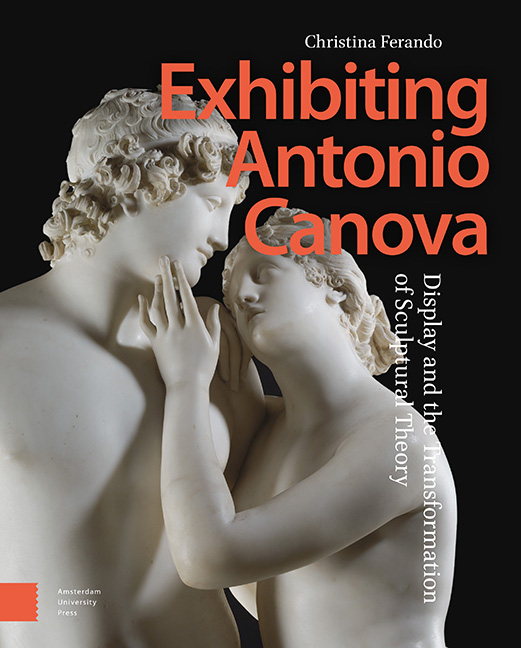Book contents
- Frontmatter
- Table of Contents
- List of Illustrations
- Acknowledgements
- Introduction: Canova on Display
- 1 Imagining Sculptural Practice
- 2 Reevaluating Ancients and Moderns
- 3 Anatomizing the Female Nude
- 4 Challenging the Supremacy of Painting
- 5 Defining Modern Sculpture
- Conclusion: Aftereffects
- Bibliography
- Index
5 - Defining Modern Sculpture
Published online by Cambridge University Press: 13 February 2024
- Frontmatter
- Table of Contents
- List of Illustrations
- Acknowledgements
- Introduction: Canova on Display
- 1 Imagining Sculptural Practice
- 2 Reevaluating Ancients and Moderns
- 3 Anatomizing the Female Nude
- 4 Challenging the Supremacy of Painting
- 5 Defining Modern Sculpture
- Conclusion: Aftereffects
- Bibliography
- Index
Summary
Abstract: Chapter five, “Defining Modern Sculpture,” explores the exhibition of Canova’s Penitent Magdalene in Paris. Exhibited first in the 1808 Salon and subsequently in an intimate space in the townhouse of Giambattista Sommariva, Penitent Magdalene launched a discussion about “expression” and the emotional resonance of art. Self-reflection on the part of beholders reinforced notions of individuality and the self and established Canova’s Magdalene as a particularly French and modern work. It also forged a direct link between emotional resonance and aesthetic value. The focus on expression established a universal model by which sculpture could be appreciated and relied upon accessible conceptions of empathy and lived human experience.
Keywords: Penitent Magdalene, expression, empathy, modern sculpture, Paris, conception of the self
Although sculpture reigned supreme in Italy for much of the eighteenth and nineteenth centuries, this was not the case for the rest of the continent. In France, for instance, which was quickly becoming the center of the modern art world, sculpture held an uneasy place. The rapid changes in political regimes and cultural mores privileged painting because of its relative speed of completion. Sculpture—with its immobility, solidity, and lengthy production time—seemed to be thoroughly associated with antiquity and the past. But critics’ complex responses to Canova’s Penitent Magdalene, which was exhibited in Paris at the Salon of 1808 and then subsequently in the collection of Giambattista Sommariva, interrogated how sculpture might be a modern art. Canova’s depiction of Magdalene’s anguish, her “expression,” seemed to capture sentiment in stone and transcend the limitations of the medium.
A Foreign Artist in France
Although Canova had achieved international fame by the end of the eighteenth century, the first public exhibition of his works in Paris did not occur until the 1804 Salon. Four years later, four of Canova’s marble statues, Penitent Magdalene, Hebe, Madame Mère, and Standing Cupid and Psyche, were exhibited in the 1808 Salon. Of those, Madame Mère was the most widely applauded, perhaps because no one dared criticize the representation of Napoleon’s mother. Hebe and Cupid and Psyche received mixed reviews, but it was Penitent Magdalene that inspired the most commentary (Fig. 5.1). She and Madame Mère are given pride of place in Louis-Léopold Boilly’s Napoleon Honoring the Sculptor Cartellier at the Salon of 1808 (Fig. 5.2).
- Type
- Chapter
- Information
- Exhibiting Antonio CanovaDisplay and the Transformation of Sculptural Theory, pp. 217 - 258Publisher: Amsterdam University PressPrint publication year: 2023



